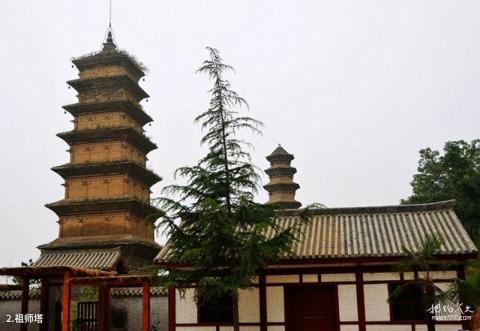
Introduction to the Patriarch's Pagoda: The Qingliang Guoshi Pagoda is a hexagonal, seven-story, six-sided brick tower, about 17 meters high. The pagoda is embedded with the inscription "The pagoda of Miaojue, the master of the Qingliang Kingdom of the Tang Dynasty". Because the pagoda was adjacent to the original bank in the west and was in danger of overturning due to rain erosion, Chang'an County demolished it in 1986 and moved it ten meters southeast from the original site to restore it on site. During the demolition, gilt-bronze Buddha statues, Thousand Buddha Steles and Buddhist scriptures were discovered in the center of each floor. Under the base of the tower, another two-story brick tower with different styles and exquisite carvings was found, about six meters high. According to records, the Qingliang Guoshi Pagoda was rebuilt in the Yuan Dynasty, but judging from the unearthed bronze Buddhas and Buddhist scriptures, they are relics from the early Qing Dynasty. It can be seen that the five-story brick pagoda on the ground should be rebuilt on the basis of the Miaojue pagoda that was destroyed when the Shaolingyuan collapsed during the Qianlong period of the Qing Dynasty in the 18th century. The two underground towers with different styles discovered during the demolition are believed to be the ruined towers rebuilt in the Yuan Dynasty. Under the ruined pagoda, a stone letter hidden in the heart of the pagoda was also found. Inside the stone letter was a white jade bottle containing the relics. On the side of Qingliang Guoshi Pagoda is a stele erected during the Yongzheng period of the Qing Dynasty in the 18th century when Cheng Guan was conferred the title of "Miaozheng Zhenyang Zen Master". After renovation, the Huayan Temple Pagoda is no longer what it used to be. The two towers face each other and reflect each other, adding a lot of brilliance to Shaoling Ancient Plains.
